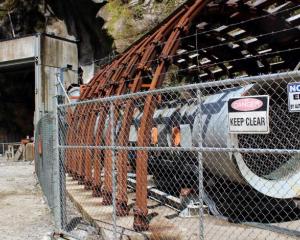A mataitai is an identified traditional fisheries ground established for the purpose of non-commercial customary food gathering.
Commercial fishers cannot take fish from a mataitai unless the Minister of Fisheries grants the right by regulation.
That has not happened for any other mataitai in New Zealand, according to the Ministry of Fisheries, but South Westland is lobbying to be the first.
A mataitai applies to all fish species managed under the Fisheries Act 1996 but does not apply to whitebait and other species managed under the Conservation Act 1987.
Eleven commercial cray fishers hold quota between the Hope River, south of Jackson Bay and the Arahura River, just north of Hokitika.
They hope the Hokitika-based runanga that has applied for the reserves will support a regulation to allow them back into the reserve areas.
Indications are the runanga is considering their request favourably.
The sticking point may be whether the Minister of Fisheries would agree to a request by the runanga, which would break new ground in the management of customary fishing grounds.
Te Runanga O Maakawhio of Hokitika began the process of establishing the mataitai several years ago and the Ministry of Fisheries advertised last month for public submissions by March 6.
Haast commercial fisherman Kerry Eggeling, who has quota for crayfish and tuna, said commercial fishers operated in four main areas that could be significantly affected by the mataitai proposal.
If shut out of those areas, they would be squeezed into other areas and that could cause overfishing in those places, he said.
The four areas of concern are Popotai and Tumaka Island near Okuru, also known as Open Bay Islands; Barn Island, near the Hope River south of Jackson Bay; Okahu Bay or Jackson Bay; and Paringa, south of Bruce Bay.
"We believe there's about 80 tonnes annually of crayfish taken off those four areas, as well as fish taken by recreational fishers," Mr Eggeling said.
An anchorage point at Mahitahi or Bruce Bay could also be affected by the proposal, he said.
Mr Eggeling said some issues needed clarifying - for example, the Jackson Bay reserve did not take into account the new mussel farm just installed there - but on the whole, the commercial fishers and the local runanga appeared to have reached common ground on protecting commercial interests.
"We have been told the Maori don't want to disrupt commercial fishing in any of those areas but they must get agreement from the Ministry of Fisheries to direct the Minister of Fisheries [Phil Heatley] to allow crayfishers back in," Mr Eggeling said.
All commercial fishers had plant set up at Haast and could not pack up and go away very easily.
Whatever happened to them, affected the community, Mr Eggeling said.
A united approach from commercial fishers and the iwi could be made to reduce catch numbers but protect community interests, he said.
An issue concerning everyone was the increased number of recreational fishers coming to the West Coast after being shut out of other areas, he said.
While recreational plunder could not be proved, people had their suspicions, he said.
Anecdotal stories included those of people arriving with freezers on trailers, staying for weeks at a time, catching their full recreational limit every day, freezing and packing it and then departing.
Some people were leaving with more fish than they could reasonably eat and it breached the spirit, if not the letter, of the laws governing recreational fishing, Mr Eggeling said.
Te Runanga O Maakawhio mataitai reserves spokesman Paul Wilson, a former commercial fisherman, said the runanga's desire to preserve the 11 identified fisheries went back to the 1970s and '80s, when the reserve areas were documented for the ministry.
Mr Wilson confirmed avenues existed to allow commercial fishers back into the reserve areas.
The runanga wanted to "make a difference" to the fisheries "so that our kids and their kids still have a fishery they can access, along with all the other families and children in the district".
The South Westland commercial fishing industry was "pretty fragile" but an essential industry, with rock lobster fishers the main people to be affected by the mataitai.
The runanga had met several times with commercial fishers and their representatives and there was "still some pretty common ground", he said.
"They are nervous about anything that affects their livelihood. They are controlled by the weather and their access to the fisheries can be quite limited. If we lock up large tracts of their fisheries it can be quite hard on them," Mr Wilson said.
The runanga was happy to work with the commercial fishers but only the minister could decide to implement a regulation allowing commercial fishing at the same time as the mataitai were created.
"We are breaking new ground in trying to negotiate the reinstatement of regulations prior to the establishment of mataitai.
"It is all new ground and because there has been no precedents . . . there could be some reluctance by the minister to run with reinstatement . . . We are trying to institute some change to give fishermen some confidence to back us."
Mr Wilson understood the Kaikoura runanga was also trying to influence a change in procedure so the regulation and establishment could occur together.
Even if commercial fishing was allowed back in a mataitai reserve, there would still be restrictions and controls of some sort, he said.
Fishing facts: Beginner's guide to mataitai
• They are traditional Maori fishing grounds.
• All commercial fishing is banned.
• Regulations may allow reinstatement of commercial takes.
• Regulations require public consultation and Cabinet approval.
• None of New Zealand's 10 established mataitai has any allowable commercial take.
• Commercial take within the reserve must be recommended by the guardian (kaitiaki).
• The Minister of Fisheries appoints the kaitiaki.
• Regulations govern how the kaitiaki can recommend commercial take.
• Recommendations for commercial take can be processed soon after a reserve is established, depending on the timing of the fishing regulation process.
• Until Cabinet approves the kaitiaki's recommendation, all commercial takes continue to be banned.
• If commercial fishers are prevented from taking their quota entitlements, the Minister of Fisheries may require the applicants to agree to conditions mitigating the loss.
• If the minister is satisfied commercial fishers are not prevented from taking their quota, and all other criteria have been met, a reserve must be established.
Source: Ministry of Fisheries













